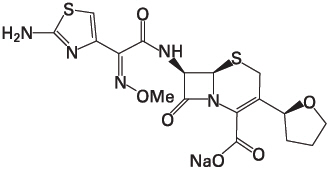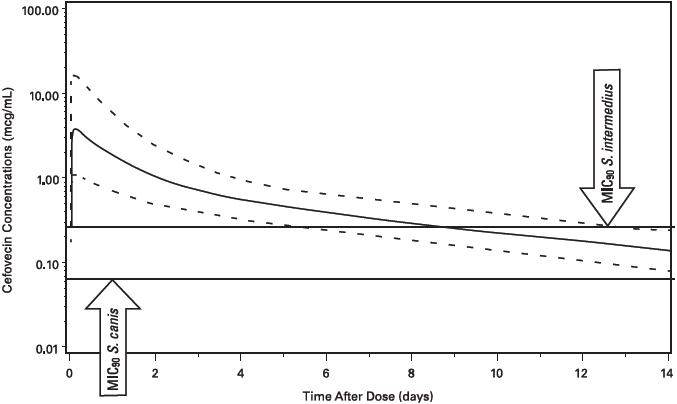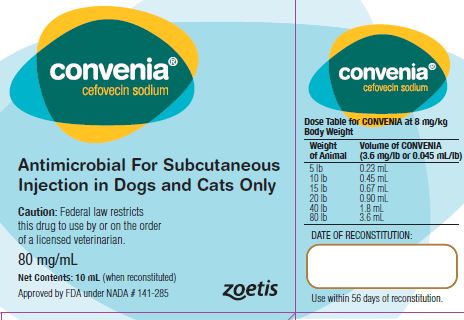Animal NDC 54771-1520-1 Convenia
Cefovecin Sodium
Animal Product Information
| Field Name | Field Value |
|---|---|
| Animal NDC Code | 54771-1520-1 |
| Proprietary Name | Convenia What is the Proprietary Name? The proprietary name also known as the trade name is the name of the product chosen by the medication labeler for marketing purposes. |
| Non-Proprietary Name | Cefovecin Sodium What is the Non-Proprietary Name? The non-proprietary name is sometimes called the generic name. The generic name usually includes the active ingredient(s) of the product. |
| Labeler Name | Zoetis Inc. |
| Product Type | Prescription Animal Drug |
| Usage Information |
|
| Active Ingredient(s) |
|
| Inactive Ingredient(s) |
|
| Marketing Category | NADA - NEW ANIMAL DRUG APPLICATION What is the Marketing Category? Product types are broken down into several potential Marketing Categories, such as NDA/ANDA/BLA, OTC Monograph, or Unapproved Drug. One and only one Marketing Category may be chosen for a product, not all marketing categories are available to all product types. Currently, only final marketed product categories are included. The complete list of codes and translations can be found at www.fda.gov/edrls under Structured Product Labeling Resources. |
| FDA Application Number | NADA141285 What is the FDA Application Number? This corresponds to the NDA, ANDA, or BLA number reported by the labeler for products which have the corresponding Marketing Category designated. If the designated Marketing Category is OTC Monograph Final or OTC Monograph Not Final, then the Application number will be the CFR citation corresponding to the appropriate Monograph (e.g. “part 341”). For unapproved drugs, this field will be null. |
Convenia Animal Product Labeling Information
The product labeling information includes all published material associated to a drug. Product labeling documents include information like generic names, active ingredients, ingredient strength dosage, routes of administration, appearance, usage, warnings, inactive ingredients, etc.
Table of Contents
Caution
Federal law restricts this drug to use by or on the order of a licensed veterinarian.
Description
Cefovecin sodium is a semi-synthetic broad-spectrum antibacterial agent from the cephalosporin class of chemotherapeutic agents. Cefovecin is the non-proprietary designation for (6R,7R)-7-[[(2Z)-(2-amino-4-thiazolyl)(methoxyimino)acetyl]amino]-8-oxo-3-[(2S)-tetrahydro-2-furanyl]-5-thia-1-azabicyclo[4.2.0]oct-2-ene-2-carboxylic acid, monosodium salt.
Figure 1: Chemical structure of cefovecin sodium.
Each mL of CONVENIA reconstituted lyophile contains cefovecin sodium equivalent to 80.0 mg cefovecin, methylparaben 1.8 mg (preservative), propylparaben 0.2 mg (preservative), sodium citrate dihydrate 5.8 mg and citric acid monohydrate 0.1 mg, sodium hydroxide or hydrochloric acid as required to adjust pH.
Contraindications
CONVENIA is contraindicated in dogs and cats with known allergy to cefovecin or to β-lactam (penicillins and cephalosporins) group antimicrobials. Anaphylaxis has been reported with the use of this product in foreign market experience. If an allergic reaction or anaphylaxis occurs, CONVENIA should not be administered again and appropriate therapy should be instituted. Anaphylaxis may require treatment with epinephrine and other emergency measures, including oxygen, intravenous fluids, intravenous antihistamine, corticosteroids, and airway management, as clinically indicated. Adverse reactions may require prolonged treatment due to the prolonged systemic drug clearance (65 days).
Warnings
Not for use in humans. Keep this and all drugs out of reach of children. Consult a physician in case of accidental human exposure. For subcutaneous use in dogs and cats only. Antimicrobial drugs, including penicillins and cephalosporins, can cause allergic reactions in sensitized individuals. To minimize the possibility of allergic reactions, those handling such antimicrobials, including cefovecin, are advised to avoid direct contact of the product with the skin and mucous membranes.
Precautions
Prescribing antibacterial drugs in the absence of a proven or strongly suspected bacterial infection is unlikely to provide benefit to treated animals and may increase the risk of the development of drug-resistant animal pathogens.
The safe use of CONVENIA in dogs or cats less than 4 months of age (see Animal Safety) and in breeding or lactating animals has not been determined. Safety has not been established for IM or IV administration. The long-term effects on injection sites have not been determined. CONVENIA is slowly eliminated from the body, approximately 65 days is needed to eliminate 97% of the administered dose from the body. Animals experiencing an adverse reaction may need to be monitored for this duration.
CONVENIA has been shown in an experimental in vitro system to result in an increase in free concentrations of carprofen, furosemide, doxycycline and ketoconazole. Concurrent use of these or other drugs that have a high degree of protein-binding (e.g. NSAIDs, propofol, cardiac, anticonvulsant, and behavioral medications) may compete with cefovecin binding and cause adverse reactions.
Positive direct Coombs' test results and false positive reactions for glucose in the urine have been reported during treatment with some cephalosporin antimicrobials. Cephalosporin antimicrobials may also cause falsely elevated urine protein determinations. Some antimicrobials, including cephalosporins, can cause lowered albumin values due to interference with certain testing methods.
Occasionally, cephalosporins and NSAIDs have been associated with myelotoxicity, thereby creating a toxic neutropenia4. Other hematological reactions seen with cephalosporins include neutropenia, anemia, hypoprothrombinemia, thrombocytopenia, prolonged prothrombin time (PT) and partial thromboplastin time (PTT), platelet dysfunction and transient increases in serum aminotransferases.
Contact Information
For a copy of the Safety Data Sheet or to report adverse reactions, call Zoetis Inc. at 1-888-963-8471. For additional information about adverse drug experience reporting for animal drugs, contact FDA at 1-888-FDA-VETS or at www.fda.gov/reportanimalae.
Pharmacokinetics
Cefovecin is rapidly and completely absorbed following subcutaneous administration. Non-linear kinetics is exhibited (plasma concentrations do not increase proportionally with dose). Cefovecin does not undergo hepatic metabolism and the majority of a dose is excreted unchanged in the urine. Elimination also occurs from excretion of unchanged drug in the bile. Cefovecin is a highly protein bound molecule in dog plasma (98.5%) and cat plasma (99.8%) and may compete with other highly protein bound drugs for plasma protein binding sites that could result in transient, higher free drug concentrations of either compound. Pharmacokinetic parameters following subcutaneous dosing at 8 mg/kg in the dog and cat are summarized in Table 4.
| PARAMETER | MEAN ± SD SD = standard deviation or (Range) | |
|---|---|---|
| Dogs | Cats = a phase effect was observed, only data for the first phase are provided (n=6); all other data provided are derived from 12 animals | |
| Terminal plasma elimination half-life, T1/2 (h) = SC = harmonic mean | 133 ± 16 | 166 ± 18 |
| AUC0-inf (μg∙h/mL) = geometric mean | 10400 ± 1900 | 22700 ± 3450 |
| Time of maximum concentration, Tmax (h) | 6.2 (0.5-12.0) | 2.0 (0.5-6.0) |
| Maximum concentration, Cmax (μg/mL) = arithmetic mean | 121 ± 51 | 141 ± 12 |
| Vdss (L/kg) = IV | 0.122 ± 0.011 | 0.090 ± 0.010 |
| CLtotal (mL/h/kg) | 0.76 ± 0.13 | 0.350 ± 0.40 |
Storage Information
Store the powder and the reconstituted product in the original carton, refrigerated at 2° to 8° C (36° to 46° F). Use the entire contents of the vial within 56 days of reconstitution. PROTECT FROM LIGHT. After each use it is important to return the unused portion back to the refrigerator in the original carton. As with other cephalosporins, the color of the solution may vary from clear to amber at reconstitution and may darken over time. If stored as recommended, solution color does not adversely affect potency.
How Supplied
CONVENIA is available as a 10 mL multi-use vial containing 800 milligrams of cefovecin as a lyophilized cake.
References
1Pillai SK, Moellering RC, and Eliopoulos GM. 2005. Antimicrobial combinations, pp 365-440. In V. Lorian (ed.) Antibiotics in Laboratory Medicine, 5th ed., Lippincott, Williams, and Wilkins, Philadelphia, PA.
2Fish DN, Choi MK, and Jung R: Synergic activity of cephalosporins plus fluoroquinolones against Pseudomonas aeruginosa with resistance to one or both drugs. Journal of Antimicrobial Chemotherapy (2002) 50, 1045–1049.
3Mayer I and Nagy E: Investigation of the synergic effects of aminoglycoside-fluoroquinolone and third-generation cephalosporin combinations against clinical isolates of Pseudomonas spp. Journal of Antimicrobial Chemotherapy (1999) 43, 651–657.
4Birchard SJ and Sherding RG. Saunders Manual of Small Animal Practice, 2nd edition. W.B. Saunders Co. 2000: p. 166.
Principal Display Panel - 10 Ml Vial Carton
* The information on this page is for an ANIMAL PRODUCT, please review the complete disclaimer below.



